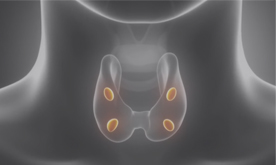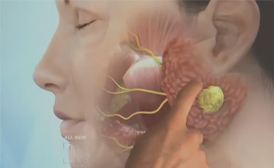Thyroid Nodule

A thyroid nodule is a growth in the thyroid gland. It always start as a small lumpand gradually, in time, grow to be larger. The growth pattern of nodules is unpredictable. Some will always stay small, some may grow and then at some point stop growing, while others continue to grow indefinitely. To understand why nodules develop one must understand the function of the thyroid gland.
The thyroid gland is a very active gland; it is always producing and storingthyroid hormones called Thryoxine (T4) and Triiodothyronine (T3). These hormones control our body’s metabolism, temperature, heart rate to name a few.

The pituitary gland in the brain measures the amount of T4 & T3 in the blood and decides if it’s adequate or not. If the pituitary finds the amount of thyroid hormones to be too low it produces TSH (thyroid stimulating hormone). TSH not only stimulates production of thyroid hormones, but if TSH stays high for a long time it leads to the growth of the thyroid gland.
Under the microscope the thyroid gland looks like a sponge. There are hollow areas that are filled with a liquid called colloid which contains the thyroid hormones bound to a protein called thyroglobulin. These areas are called colloid lakes, and are surrounded by follicle cells that produce the thyroid hormones T3 & T4, as well as thyroglobulin. In between the follicle cells are blood vessels that carry the thyroid hormone to the rest of the body. There’s also parafollicular cells that produce another type of hormone called calcitonin that is involved in controlling the level of calcium in the blood. Most nodules develop from the follicle cells.
How To Distinguish Between The Different Thyroid Nodules
Most nodules are discovered incidentally when a scan is performed for other reasons. Which means that most nodules are found when they are smaller. The following tests can help distinguish between different types of nodules:
- Thyroid blood tests – TSH, Free T3 & Free T4
- Ultrasound
- Needle biopsy
Needle Biopsy or FNA of Thyroid Nodules
Needle biopsy or FNA (fine needle aspiration) is the most definitive way to diagnose what type of thyroid nodule a person is dealing with. It is very simple procedure done in the office of endocrinologists or thyroid surgeons. It involves using the ultrasound machine to locate and visualize the nodule. Once the nodule is clearly seen the skin over it is numbed with anesthetic cream and then anesthetic injection. Then a very small needle is used that can be seen on ultrasound to go through the thyroid gland and into the nodule. As the needle goes through the nodule it scrapes off cells that enter the hollow center of the needle. These cells are then placed on glass slide and sent to the pathologist to look at under the microscope to determine what type of nodule it is. The results are reported based on the Bethesda System which helps stratify chance of a nodule being a cancer and recommendations for management. This allows you and your doctor to make an appropriate decision in regards to the nodule of wether continuing to observe it, or if it is better to remove it.
Can Thyroid Nodules Cause Any Symptoms
Yes they can, either because they produce excess thyroid hormones or by growing and pushing on a adjacent structures. As part of the work up for thyroid nodules the level of thyroid hormones (TSH, Free T3 & Free T4) should be checked which can tell you if there is hormonal imbalance caused by the nodule.
Additionally, if the nodule is large enough it can compress surrounding structures like the esophagus (swallowing tube) causing swallowing issues, such as food getting stuck in the throat or passing slowly down past the throat. If it compresses the trachea (breathing tube) then the person may have shortness of breath or coughing. If it is a cancer that damages the testing is done on a nodule and the known mutations are present then the chances of the nodule being a cancer is higher.
Treatment
There are a few choices in terms of how to address thyroid nodules, the options are based on the type of nodule and the symptoms it is causing.
- Observation – If a nodule appears small, not causing a hormonal imbalance, and is not suspicious on ultrasound, then monitoring with ultrasound alone will be appropriate.
- Thyroid Surgery – If the nodule is large, pressing on surrounding structures (trachea or esophagus), or has suspicious/concerning needle biopsy results then removal of the half or the entire thyroid may be appropriate. Thyroid surgery is also recommended if a nodule is showing fast growth rates even though the needle biopsy is benign.
- Thyroid RFA – If a nodule is large or growing and it doesn’t have features that make it suspicious for a cancer then RadioFrequency Ablation (RFA) would be appropriate. RFA is a non-surgical technique that uses a small needle like probe that is placed inside the nodule under ultrasound guidance that destroys the nodule without having to surgically open the neck.









